As the weather starts to heat up, we rely increasingly on our air conditioning units to keep us cool and comfortable. But have you ever noticed a musty smell coming from your AC vents?
If so, the culprit could be a clogged air conditioner drain. Over time, dirt, dust, and other debris can build up in the drain line, leading to blockages and unpleasant odors. But fear not because there’s a simple solution: bleach. Well, hold on for a minute.
Why Use Bleach?
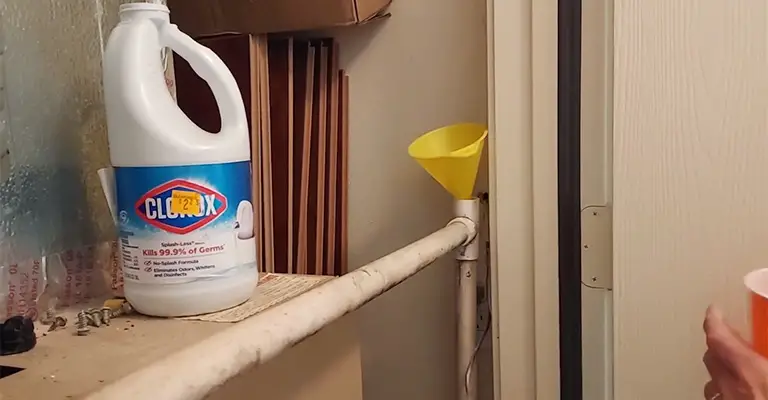
As mold and algae grow in the air conditioner condensate drain pan, bleach will kill them. Condensation from the air conditioner creates a moist environment that thrives these bacteria.
The motor of the air conditioner produces a small amount of heat, so the water in the pan stands still. In this environment, mold and algae can grow readily.
Blockages in the condensate drain pan result from debris, contaminants, bacteria, and algae accumulating.
Mold spores can also be released into the air circulating throughout your house. As long as you and your family remain healthy, bleach effectively kills these harmful organisms.
Is It Safe To Put Bleach In The Ac Drain Line?
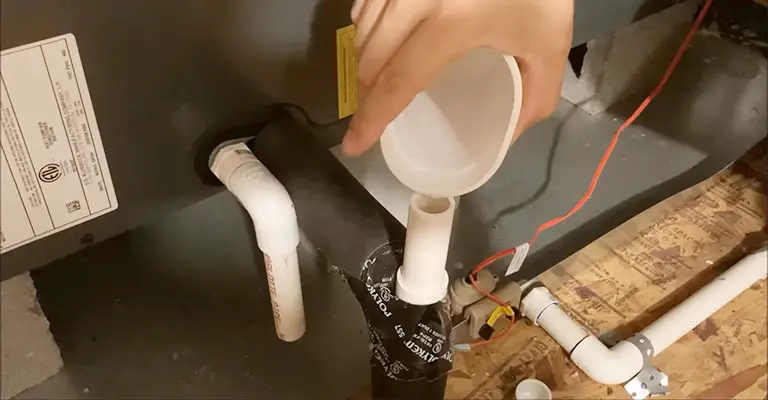
In the summertime, it is common to encounter a clogged condensate drain line on an A/C system. A/C drain lines can become blocked by pollutants like dust, pollen, and other debris as temperature and humidity rise.
You may experience water overflowing into the overflow pan of your unit as a result of these issues.
Additionally, drain line clogs can cause water damage to your home and system and have a negative effect on your HVAC system’s performance.
When it comes to clogs in AC drain lines, homeowners can often remove them themselves, but first, they must understand a few things before mixing bleach and water.
The common recommendation for flushing out a clogged drain line with bleach is detrimental. It is known that bleach contains chemicals that cause the metal to corrode.
Your units’ evaporator coils are at risk of corrosion due to the drain line access point being close to them. The copper in drain lines used instead of PVC pipes will also be corroded by bleach.
Regular maintenance on a unit’s condensate drain line is highly recommended. If you repeatedly use bleach on copper piping, your drain line eventually needs to be replaced.
It is, therefore, up to you to put away your bleach and vinegar, and please trust our advice. While vinegar or bleach is commonly recommended for cleaning AC drain lines, we will explain why it isn’t recommended.
Bleach And Vinegar Are Corrosive To Metals
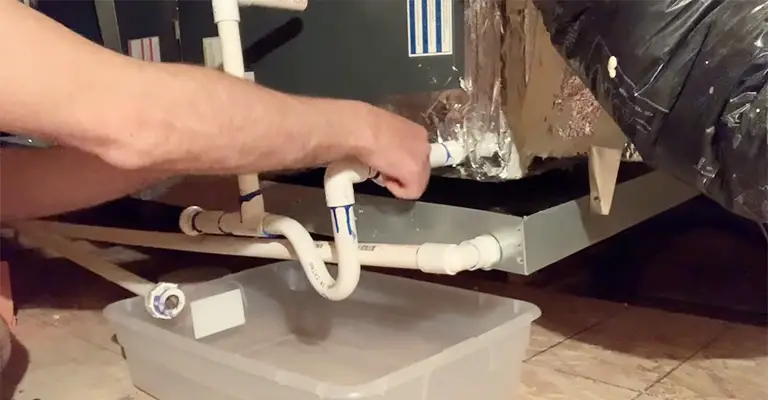
Bleach or vinegar is corrosive to metals, which explains why you shouldn’t use them to clean your AC drain line. This means that they literally eat away at metal.
They Can Damage Your Evaporator Coil
In your indoor air handler, you will find the evaporator coil. You will normally find it just a few inches from your AC drain line.
The evaporator coil removes moisture from the air and cools it. Water from the evaporator coil collects in the drain line and is carried away from your home through the drain.
A copper or aluminum coil is generally used in an evaporator. How does an evaporator coil react to corrosive chemicals like bleach or vinegar? Corrosion is on the way!
If you feel your AC drain line is clogged, using bleach or vinegar can be especially hazardous. A clogged drain line will simply back up the corrosive mixture and force it into your drain pan, which can damage your evaporator coil.
How To Clean An A/C Condensate Drain Line?
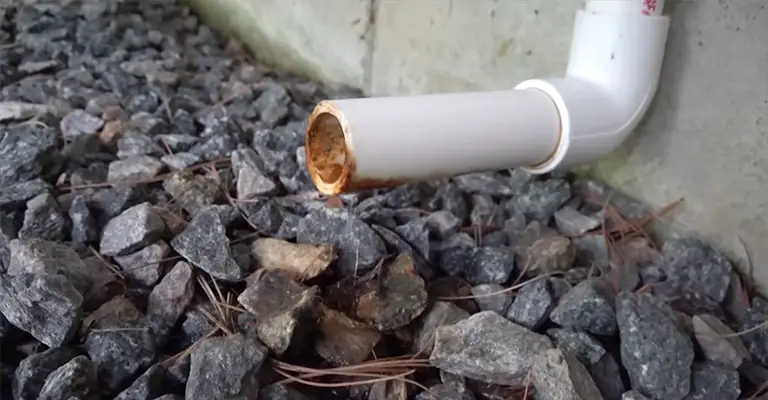
You may be able to get water spilling onto the ground if you fail to clean out the drain line on your AC unit when it’s clogged. It is, therefore, imperative to keep your AC drain lines clean on a regular basis.
What should you do instead if using bleach or vinegar can damage your evaporator coil? To replace bleach with another solution, there are several options available. Here is what we need to do:
Attempt To Manually Clear Any Blockage
The first thing you should do is manually remove the blockage with your hands. Ensure you don’t have clogs at the end of your drain line (located outside your home). You can clean debris away by reaching inside and using your fingers.
Plunger Method
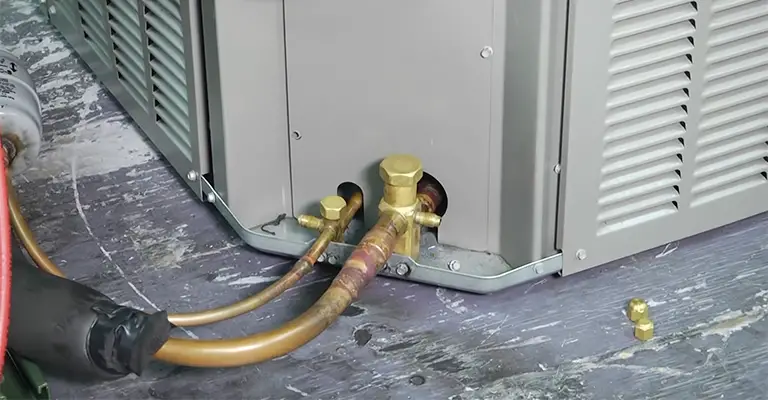
When they have a clogged drain line, people first think of using boiling water to unclog it, but it’s not always effective.
The solution is still a good one, however. Plungers may be needed depending on how many drains are clogged. Keeping that in mind will help you get the job done fast.
Fortunately, plungers are relatively inexpensive and easy to find, so many people use them as soon as they encounter a clog.
Use A Shop Vac And Water
After that, attach your shop vac hose to the drain line (the one outside). Using duct tape or cloth, you can create an airtight seal if the hose is loosely connected. Pump up the vacuum.
Additionally, get a gallon jug of water and a funnel. Slowly pour water into the drain line access point near the air handler using a cup. Your shop vac should suction the water (and any debris) out of the drain line and into the vacuum.
When the clog refuses to loosen, water will back up into your drain line, potentially leaking onto your floor.
Use A Drain Snake
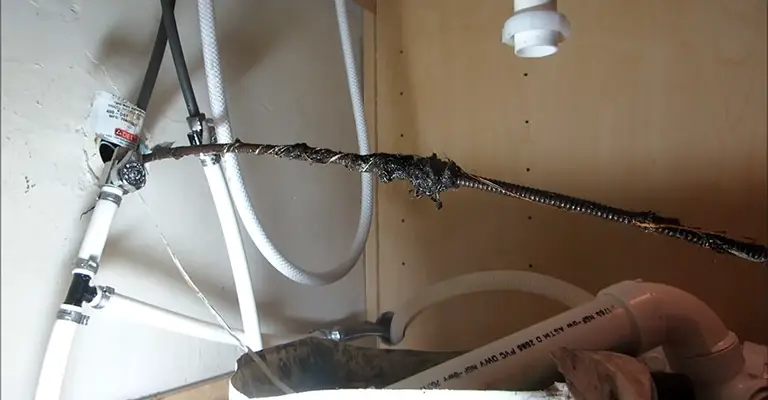
You can use a drain snake if there is a clog that is stubborn and won’t come out with a shop vac or water. Enter the drain snake into the line access near the air handler.
Your evaporator coil may be damaged if the drain snake approaches your air handler.
Use a Vinegar Solution
Mix 1/4 cup warm water with 1/4 cup white vinegar when you have a stubborn clog. Pour the solution into your drain line’s access point, then wait 30 minutes, and then flush with warm, clean water.
It will help kill any bacteria or mold growth that might be clogging up your A/C drain line with vinegar.
Rebuild The Drain Line
Some clogs are so ingrained and hardened that it is impossible to clear them without completely rebuilding the drain line. The extreme approach has only ever been warranted in a few situations, but we want to consider it as an alternative.
Pour One Cup Of Bleach Down The Drain Line
In addition to destroying algae, bleach can also break down other deposits that have accumulated in your drain lines.
In the same way that vinegar kills bacteria and mold, this tool also kills most fluoride-producing bacteria. Maintain the health of your drain lines by pouring bleach down them every month.
Your AC drain line can be unclogged with one cup of bleach, which is the cheapest and easiest solution. It is important not to use any other chemical type because bleach could negatively react with other chemicals.
Put as much bleach as you can down the drain line at once. If you do this, the bleach will remain in one spot, and it won’t be able to cause clogs.
After pouring the bleach, let it sit for an hour or two before running water down the drain again. It is your goal to have the bleach eat away at any mold or mildew that might be causing the problem.
How To Tell if Your Condensate Drain Line is Clogged?
Condensate drain lines blocked by debris may cause homeowners to experience the following:
- Poor cooling efficiency.
- Indoor air feels humid or “clammy.”
- Overflow pan of the HVAC unit is filling up or leaking.
Final Words
Cooling your home with an air conditioner removes moisture from the atmosphere. There is somewhere for condensate to go from the evaporator coils: into the condensate pan.
Eventually, the water leaves your home through the AC drain line. Mold is, however, present wherever moisture is present. Regularly cleaning your air conditioner drain line can prevent the buildup of Bold from leading to leaks (or shutting your cooling system off).
When you’re using bleach or vinegar, be careful not to get any on the metal parts. You can damage metal surfaces if you leave undiluted vinegar or bleach on them.
However, it should be easy to avoid splashing if you use a funnel or measuring cup. Ensure that all vinegar spots and bleach stains are removed from metal surfaces before switching back on your system.






